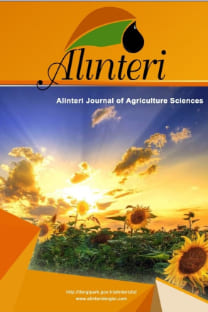Identification and Mapping of Wetland Plants in Erzurum
___
Akaya, H., 1996. Aksu (Antalya) Havzası Su Kanalları ve Çevresi Bitkileri. Yüksek Lisans Tezi, Gazi Üniversitesi Fen Bilimleri Enstitüsü, (Unpublished) Ankara.Altınayar, G., 1988. Su Yabancı Otları, Bayındırlık ve İskân Bakanlığı Yayınları, Ankara.
Anonymous, 2005. Çayır ve Mera Bitkileri Klavuzu. Tarım ve Köyişleri Bakanlığı.
Anonymous, 2007. Ramsar Convention on Wetlands. www.ramsar.org
Anonymous, 2020a. https://webdosya.csb.gov.tr/db/ced/icerikler/erzuru m_-cdr2018-20190906171600.pdf
Anonymous, 2020b. https://www.mgm.gov.tr/veridegerlendirme/il-veilceler-istatistik.aspx?m=ERZURUM
Anonymous, 2020c. http://www.turkiyesulakalanlari.com/wp-content/uploads/sulak-alanlar-kitab%C4%B1- bask%C4%B1-onay%C4%B1-i%C3%A7in.pdf
Behçet, L., 1994. Erçek, Turna ve Bostaniçi (Van) Göllerinin Vejetasyonu, Doğa Türk Botanik Dergisi, 18, (4), 305- 312.
Behçet, L., Altan, Y., 1994. Van, Erçek, Turna ve Bostaniçi Gölleri’nin Sucul Florası, Doğa Türk Botanik Dergisi, 18, 91-98.
Behçet, L.& Özgökçe, F., 1996. Doğu Anadolu Bölgesinin Bazı Göllerindeki Sulak Alanların Florası, Ot Sistematik Botanik Dergisi,3(2),3-14.
Behçet, L.& Özgökçe, F., 1998. The Vegetation of Some Lakes in East Anatolia (Turkey). Bulletin of Pure and Applied Science Vol. 117 B (No. 1),1-15.
Cook, D. K., 1996. Aquatic Plant Book. SPB Academic Publishing, Amsterdam, New York.
Davis, P.H., 1982. Flora of Turkey and the East Aegean Islands, vol-IX, University Press, Edinburg.
Ekim, T., Koyuncu, M., Vural, M., Duman, H., Aytaç, Z. and Adıgüzel, M. (2000). Türkiye Bitkileri Kırmızı Kitabı (Eğrelti ve Tohumlu Bitkiler), Türkiye Tabiatını Koruma Derneği, Van 100.Yıl Üniversitesi. Barışcan Ofset. Ankara.
Güçlü, K.&Yılmaz, H., 1989. Doğu Anadolu'da Doğal Olarak Yetişen Huşların (Betula pendula L.) Üretilmesi ve Peyzaj Mimarlığında Kullanılma Olanakları. Atatürk Üniversitesi Ziraat Fakültesi Dergisi, 21 (2), 101–110.
Hozhina, E.I., Khramov, A.A., Gerasimov, P.A. and Kumarkov, A.A. 2001. Uptake of heavy metals, arsenic, and antimony by aquatic plants in the vicinity of ore mining and processing industries. Journal of Geochemical Exploration, 74,153-162.
Keskinkan O., Goksu M.Z.L., Yüceer, A., Basibuyuk, M. and Forster, C.F. 2003. Heavy metal adsorption characteristics of a submerged aquatic plant (Myriophyllum spicatum) Process Biochem, 39,179-183.
Kıroğlu, E., 2007. Erzurum kenti ve yakın çevresindeki bazı rekreasyon alanlarının göresel peyzaj kalite yönünden değerlendirilmesi. Yüksek Lisans Tezi. Atatürk Üniversitesi Fen Bilimleri Enstitüsü, (Unpublished), Erzurum.
Rubio, R., Chancho, R., Lopez Sanchez, J.F. and Rubio Lopez, J.F. 2009. Sample pre-treatment and extraction methods that are crucial to arsenic speciation in algae and aquatic plants. TrAC Trends in Analytical Chemistry. 29 (1) 53-69. https://doi.org/10.1016/j.trac.2009.10.002
Seçmen, Ö., Leblebici, E., 1997. Türkiye Sulak Alan Bitkileri ve Bitki Örtüsü. Ege Üniversitesi Fen Fakültesi Yayınları No: 158, İzmir.
Seçmen, Ö., Leblebici, E., 1982. Türkiye florasındaki kareler için yeni kayıtlar. (3). Ege Üniversitesi Fen Fakültesi Dergisi. Ser. B, 5/1:15-23.
Söğüt, Z., 1996. Su Bitkileri ve Peyzaj Mimarlığında Kullanımı. Çukurova Üniversitesi Ziraat Fakültesi, Genel Yayın No: 122. Ders Kitapları Yayın No:35. Adana.
Şahin, Ş., Perçin, H., Kurum, E. and Memlük, Y., 2014. Akarsu koridorlarında peyzaj onarımı ve doğaya yeniden kazandırma teknik klavuzu. T.C. Orman ve Su İşleri Bakanlığı. Doğa Koruma ve Milli Parklar Genel Müdürlüğü adına BEL-DA Belde Proje ve Dan. Tic. Ltd. Şti.
Şişli, M.N., 1996. Çevre Bilim Ekoloji. Yeni Fersa Matbaacılık, Ankara.
Tatlı, A., 1988. Erzurum Bölgesinin Yaygın Çayır ve Mera Bitkileri. Birleşmiş Milletler Gıda ve Tarım Örgütü Yayınları, Erzurum.
Tatlı, A.& Behçet, L., 1989. Dumlu Dağları (Erzurum) vejetasyonu üzerine fitososyolojik bir araştırma. Doğa Türk Botanik Dergisi. 9 (3), 398–417.
Turgut, H., 2009. Erzurum’daki Bazı Sulak Alan Bitkilerinin Tespiti Ve Bu Bitkilerin Peyzaj Mimarlığında Kullanım Olanakları. Doktora Tezi, Atatürk Üniversitesi Fen Bilimleri Enstitüsü, Peyzaj Mimarlığı Anabilim Dalı, (Unpublished), Erzurum.
Uluğ, E., Kadıoğlu, İ., Üremiş, İ., 1993. Türkiye’nin Yabancı Otları ve Bazı Özellikleri. T.C. Tarım Orman ve Köyişleri Bakanlığı, Zirai Mücadele Araş
- ISSN: 2564-7814
- Yayın Aralığı: 2
- Başlangıç: 2007
- Yayıncı: Adem Yavuz SÖNMEZ
Assessment of Oxidative Stress and Antioxidant Levels in Chronic Periodontitis Patients
Nauma HAFEEZ, Lakshmi THANGAVELU, Dr. Anitha ROY, S. RAJESHKUMAR, RV. GEETHA
First Report on Marine Actinobacterial Diversity around Madras Atomic Power Station (MAPS), India
P. SİVAPERUMAL, S. RAJESHKUMAR, T. LAKSHMİ
Abdirizak Mohamud YUSUF, Ekrem LAÇİN
Evaluation of Optimal Area Usage in Kastamonu City Center in terms of Landscape Planning
Sevgi ÖZTÜRK, Merve Kalaycı KADAK
Characterization of New Salt-Tolerant Rice Genotypes with Superior Agronomical and Cooking Traits
Mohammad Taher HALLAJİAN, Ali Akbar EBADİ, Mohammad MOHAMMADİ, Saba DELFAN
Assessment of Azerbaijan Durum Wheat Genotypes Under Drought and Non-Stress Conditions
Nahida ASADOVA, Ellada AKHUNDOVA, Samira SALAYEVA, Javid OJAGHİ
Identification and Mapping of Wetland Plants in Erzurum
S. RAJESHKUMAR, T. LAKSHMİ, M. THARANİ, P. SİVAPERUMAL
Feyza TUNCEL, Nazlı TEKKAŞ, Gökay TÜRK, Hatice Diğdem OKSAL, Hikmet Murat SİPAHİOĞLU
